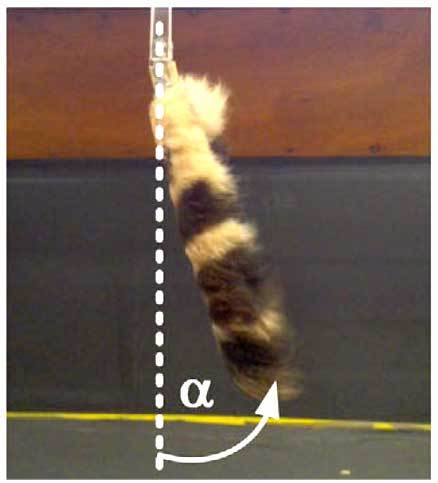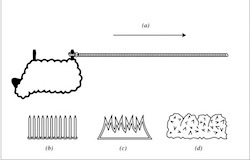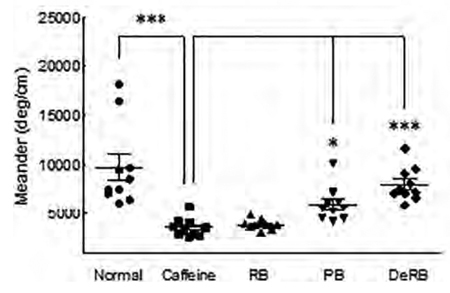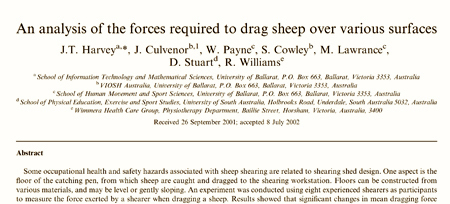Marc Abrahams's Blog, page 210
September 18, 2017
The aerodynamics of cheetahs’ tails (recent study)
“During high-speed pursuit of prey, the cheetah (Acinonyx jubatus) has been observed to swing its tail while manoeuvring (e.g. turning or braking) but the effect of these complex motions is not well understood.”
Prompting, perhaps, the question ‘what is a cheetah’s tail actually for?’
A joint US / South African study (2016) has made made steps towards answers. A set of experiments, in which tails were aerodynamically tested at various airspeeds and inclinations, in a wind tunnel, yielded results :
“[…] our first order, quasi-steady state results clearly support the hypothesis that aerodynamic effects of the cheetah’s long, furry tail contribute to the angular impulse that can be applied to the body, especially at higher speeds. Both inertial and aerodynamic effects must therefore be considered in modelling the use of the cheetah tail for manoeuvring tasks. Our results further support the observations that the cheetah tail can be used as a ‘rudder’ to contribute to fast change of heading, and as a ‘stabiliser’ during rapid acceleration and turning.”
See: Quasi-steady state aerodynamics of the cheetah tail in Biology Open (2016) 5, 1072-1076
Notes:
● The image shows the morphometric tail rig used to measure aerodynamic coefficient at varying angles of inclination and airspeed.
● The authors thank the Ann van Dyk Cheetah Centre for providing the tails.
● The authors inform that the use of the cheetah tails complied with the University of Cape Town Science Faculty Ethics policy.

September 15, 2017
Saturday — The Ig Informal Lectures, at MIT
Saturday, Sept 16, 2017, 1:00 pm
MIT, building 10, room 250 — 77 Massachusetts Avenue, Cambridge, Massachusetts, USA, Planet Earth.
You are invited. It’s free, no tickets needed. Come early to assure a seat.
A half-afternoon of improbably funny, informative, informal, brief public lectures and demonstrations:
The new Ig Nobel Prize winners have each done something that makes people LAUGH, then THINK. That’s why they were awarded Ig Nobel Prizes. In these lectures, the winners will attempt to explain what they did, and why they did it.
Two past winners will return, to share their adventures:
 Thomas Thwaites
(2016 Biology Prize — living as a goat)
Thomas Thwaites
(2016 Biology Prize — living as a goat)John Culvenor (2003 Physics Prize — Analysis of the forces required to drag sheep across various surfaces)
Everyone will be available for you to talk with, both before and after the lectures.
This video shows TV news anchors’ first reaction to seeing Thomas Thwaites in action:
Here’s a look at one of last year’s lectures — this will give you some of the flavor of this annual event. The 2016 Ig Nobel Peace Prize was awarded to Gordon Pennycook, James Allan Cheyne, Nathaniel Barr, Derek Koehler, and Jonathan Fugelsang for their scholarly study called “On the Reception and Detection of Pseudo-Profound Bullshit.” (That study was published in the journal Judgment and Decision Making, vol. 10, no. 6, November 2015, pp. 549–563.)
The Ig informal Lectures are a free event, organized in cooperation with the MIT Press Bookstore.

September 14, 2017
Watch the 27th First Annual Ig Nobel Prize Ceremony live!
UPDATE: The 27th First Annual Ig Nobel Prize Ceremony happened Thursday evening, September 14, 2017, at Sanders Theater, Harvard University. Ten new Ig Nobel Prize winners were introduced. This year’s theme was “UNCERTAINTY”. The ceremony was webcast. Here’s recorded video:

September 13, 2017
Exploring the Confusion Matrix for Auto Bidet Seat Icons (study)
When it comes to designing icons for the operation of household equipment, care must be taken to avoid misunderstandings.
“If the right button is pushed, the desired function will be performed. If the wrong button is pushed, an unexpected function will be performed. It might cause the user’s body or mental state of unwell even dangerous.“
This applies, for example, to the Auto Bidet Seat.
“Regarding functions, in addition to the basic jet water washes and warm seat, some medium class products still have other derivative features such as Deodorizer, Warm Air Dry and Remote Control. Some high class products even have broadcast music attempting to give users a more relax atmosphere in the toilet environment.”
To determine how readily (or otherwise) icons are understood, researchers Cherng-Yee Leung, Chih-Sheng Chang, and Da-Teh Wu, devised a set of experiments based on confusion matrices [as shown above]. They found that recognition-rates varied dramatically in percentage terms – from an impressive 100% in some cases, like this one :

whilst some scored in mid-range :

and others only achieved a disappointing 0%

“In the age of global village, icons have to be good media of communication because the culture, language and words of some areas are different from others. With the increases of contents and complexity of new products, it is not easy to design ideal icons for users to recognize the delicate functions. Though Auto Bidet Seat has already presented for decades on the market, many function icons, even the icons with text hint, still puzzle users.”
See: A STUDY OF RECOGNITION RATE FOR ICONS ON THE AUTO BIDET SEAT published in Proceedings of IASDR 07

September 11, 2017
Vegemite and Marmite (and cigarette butts): research studies
A collection of research studies about Marmite and Vegemite enlivens and en-goos the (digital) pages of the special Cigarette Butts, Vegemite, and Marmite issue (vol. 23, no. 4) of the Annals of Improbable Research.
The issue’s table of contents is online. And you can obtain, for a pittance, the full issue, in PDF form.

Effect of Explosion-Puffed Coffee on Fruit Flies [research study]
Fruit flies can be measurably affected by explosion-puffed coffee, suggests this new study:
“Effect of Explosion-Puffed Coffee on Locomotor Activity and Behavioral Patterns in Drosophila melanogaster,” Bong Soo Ko, So Hyun Ahn, Dong Ouk Noh, Ki-Bae Hong, Sung Hee Han, and Hyung Joo Suh, Food Research International, epub 2017.
The authors, at several institutions in South Korea and the USA, report:
“Results of the underlying mechanism of the behavioral change patterns of explosive puffed [coffee] with or without caffeine in Drosophila models, transcript level for the Dop1-R1 receptor in caffeine group was significantly higher than normal, PB, and DePB groups. Flies exposed to the caffeine had significantly decreased transcript levels for the GABA receptors. PB 7.5 and DePB showed higher level of GABA content than RB.”
Here’s further detail from the study:


Psycho-emotional status regulation of minigolf players (study)
When it comes to sporting activities, the psycho-emotional state of the players can have a profound effect on their performance. What positive steps can be taken to enhance it? A number of strategies are currently available :
“[…] various ways and their combinations based on physiological reflexes are applied: breath holdings, relaxation of facial muscles, deep respiration, the arbitrariest synkineses, etc.”
How would such methods impact on the performance of, say, mini-golf players? A newly published study by Russian researchers Aleksey Korolkov, Evgeny Lysov and Oksana Frizen has referenced not only arbitrariest synkineses, but also the effects of aromas and music etc etc.
“It is established that the effect of influence of the functional music is comparable with effect of influence of an activating odorant and exhaustion. Significant distinctions in medians of Kerdo’s index by Vilkokson’s criterion for pair data at the level of a statistical significance are revealed statistically р =0.05. Besides, the effect of decrease in rate of game actions and increase of their stability after musical influence is established. “
See: About Ways of Psyhoemotional [sic] Status Regulation of Minigolf Players in MOJ Sports Med 2017, 1(1): 00004.
Note: There may still be time to book tickets for the World Minigolf Sport Federation Delegates Conference 2017, to be held in Nin (Croatia), Zaton Holiday Resort, September 17, 2017.

September 10, 2017
Is cheese rational?
The Chetham Library blog reveals a bit of cheese-centric history, with the headline “Is cheese rational?“:
John Byrom, who owned this little manuscript before it came to the Library, was an enthusiast of all things mystical. An earlier reader seems less than convinced by the arguments our scribe expresses. As the argument builds to the climax of cheesy transformation, a manicule, or pointed finger in the margin, engages with the text, asking, ‘Is cheese rational?’. On the next page another manicule continues the silent argument…
A 1978 report in the Danish Dairy Industry journal explores that thought, sort of, with the headline “Rational cheese production“.

September 9, 2017
“What Colour is Penguin Guano?” [research study]
A new study reports progress on an old chestnut of a question:
“What Colour is Penguin Guano?” W.G. Rees, J.A. Brown, P.T. Fretwell, and P.N. Trathan, Antarctic Science, vol. 29, no. 5, October 2017 , pp. 417-425. (Thanks to Tom Gill for bringing this to our attention.) The authors, at the University of Cambridge and the British Antarctic Survey explain:

“The identification and quantification of Antarctic Pygoscelis penguin colonies depends increasingly on recognition of the characteristic optical properties of guano deposits, but almost all knowledge of these properties until now has been compromised by resolution and atmospheric propagation effects. Here we present hyperspectral reflectance data in the range 350–2500 nm, collected in situ from fresh guano deposits in Pygoscelis penguin colonies on Signy Island, South Orkney Islands. The period of data collection included the transition from predominantly white guano to the pink coloration characteristic of a krill-rich diet. The main identifiable features in the spectra are a broad absorption feature centred around 550 nm, responsible for the pink coloration and identified with the pigment astaxanthin, as well as several water absorption features…. From these results we propose two spectral indices suitable for use with satellite data, one of which responds to the presence of astaxanthin in the guano and the other to water. Our results do not allow us to differentiate between penguin species from their guano, but do suggest that the breeding phenology of Pygoscelis penguins could be determined from a time series of multispectral imagery.”

September 7, 2017
Analysis of the Forces Required to Drag Sheep Over Various Surfaces
“An Analysis of the Forces Required to Drag Sheep over Various Surfaces” is a research study that won the 2003 Ig Nobel Prize in physics for its co-authors — Jack Harvey, John Culvenor, Warren Payne, Steve Cowley, Michael Lawrance, David Stuart, and Robyn Williams, of Australia.
John Culvenor, one of the authors, has just boarded an airplane (that’s him, there, in the photo below!) that will take him from Australia to the United States, where he will return to the Ig Nobel Prize ceremony.

Dr. Culvenor will take a bow at the 27th First Annual Ig Nobel Prize ceremony, at Harvard, on Thursday evening, September 14. You can watch the ceremony webcast. There is some (though not much) mystery as to whether he will be accompanied by a sheep.
Two days later, on Saturday afternoon, September 16, He will give a brief talk, and answer questions, at the Ig Informal Lectures, at MIT. The new Ig Nobel Prize winners will each give brief talks there, too. And so will one other past Ig Nobel Prize winner: Thomas Thwaites, who shared the 2015 Ig Nobel Prize for biology, for creating prosthetic extensions of his limbs that allowed him to move in the manner of, and spend time roaming hills in the company of, goats.
You are invited to come to the lectures, and shake hands or hooves with these Ig Nobel Prize winners.

Marc Abrahams's Blog
- Marc Abrahams's profile
- 14 followers






